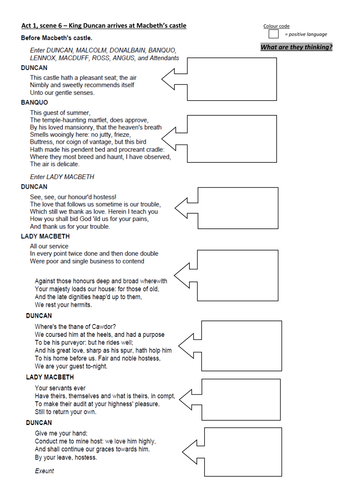


In this lesson students are asked to comment on what Lady Macbeth's use of language shows about her intentions within the story. As with the last lesson, there is emphasis on how dramatic irony works within scene. Students are asked to identify where she is deliberately being polite in order to hide her murderous intentions towards Duncan who has arrived at her castle. After this stage, students are then asked to find imagery within her dialogue which is a key skill that these lessons encourage throughout the project.
All lessons in this series include:
- Links to online videos (see 'Notes' under Powerpoint slides)
- Starter tasks which introduce the main idea of the lesson
- Differentiated tasks
- Opportunities for pair and group talk within activities ('Talk for Writing')
- Handouts of scenes or a selection of quotes from scenes studied
- Alternating opportunities for self and peer assessment
- Essay writing prompts to allow students to write about the scene
- References to the AQA English Literature mark scheme for Paper 1, particularly to the demands for attaining a grade 5 - what is considered a 'good pass' for the qualification.
It's suggested that you download the whole series to appreciate the full learning journey.
All lessons in this series include:
- Links to online videos (see 'Notes' under Powerpoint slides)
- Starter tasks which introduce the main idea of the lesson
- Differentiated tasks
- Opportunities for pair and group talk within activities ('Talk for Writing')
- Handouts of scenes or a selection of quotes from scenes studied
- Alternating opportunities for self and peer assessment
- Essay writing prompts to allow students to write about the scene
- References to the AQA English Literature mark scheme for Paper 1, particularly to the demands for attaining a grade 5 - what is considered a 'good pass' for the qualification.
It's suggested that you download the whole series to appreciate the full learning journey.
Something went wrong, please try again later.
An excellent resource that helps students to develop an analytical response.
Amazing! Very very helpful! Thank you.
Report this resourceto let us know if it violates our terms and conditions.
Our customer service team will review your report and will be in touch.
£3.00